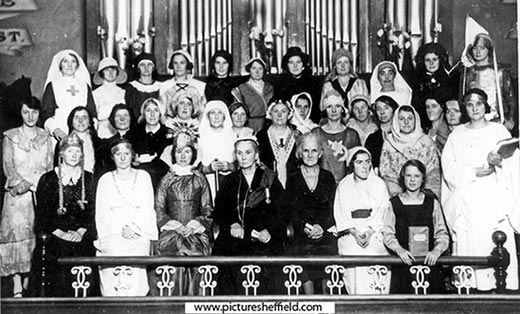History Society Report
Changing Times, Changing Heroines
Speaker:Amy Binns
Wednesday, 3 October 2018
If you were asked to nominate women you think of as heroines, who would you choose? Would you choose from the current day, from history, from our nation or from overseas?

Sheffield pageant
Amy Binns, lecturer at the University of Central Lancashire and author of Valley of a Hundred Chapels, asked the audience at Hebden Bridge Local History Society meeting to write down their nominations. There was quite a range, from historical figures such as Boudicea and Joan of Arc to the Pankhursts and twentieth century politicians such as Margaret Thatcher and Barbara Castle.
Writers of all kinds were represented as well as women in the fields of science and mathematics.This is our current day view offering - a wide choice of women who have achieved great things. However, in the past it was not quite the same. During the times of the suffragettes and their struggle, warrior Joan of Arc was the most prominent heroine. However, when women gained the vote a century ago, they also gained a new status. No longer outlaws, they were now citizens, and had to learn to live with a new identity and the opportunities that offered.
This was reflected in their leisure activities. In the local non-conformist chapels, the ladies of the congregation began to come together to organize events that celebrated the role of women. They organised pageants of great women to perform a new historical narrative that would support and cement this new status. These would often take the form of a narrator in guise of Clio, the muse History, telling a child about the heroines, who would then appear in character costumes. These pageants became immensely popular from around 1916 until well into the 1930s and some still occurred as late as the 1950s.
Amy has found reference to these events in the local newspapers of the time. Not only was the pageant advertised, reports of the event would list the characters and the names of the participants. This was also good for the newspapers as the more local names, the more newspapers sold!
From these many reports Amy was able to compile a list of those considered the most famous and influential women by local people. The top ten of that time was headed by Florence Nightingale, Boudicea and Grace Darling. Joan of Arc is still there as are the Queens Elizabeth 1st and Victoria. But also several names that are associated with non-conformist religions, such as Elizabeth Fry, Susannah Wesley, mother of John and Charles Wesley, and Catherine Booth, the wife of William Booth, the founder of the Salvation Army. These names reflected the changing society of the small working class towns in the northern part of the country, with an emphasis on Christian values and a generally progressive attitude to the rights of women and their standing in the community.
The collection of names submitted by our audience caused much interest and left us thinking about the changes that have occurred in society since those times, and, perhaps a bit nostalgically, for the loss of the camaraderie found in the community groups in the past.
The next meeting of the History Society will be on October 10th when Roger Frost will talk about The Whittakers and The Holme at Cliviger. All meetings are held in the Methodist Church on Market Street in Hebden Bridge and begin at 7.30pm.
With thanks to Barbara Atack for this report
Details of all the Society’s activities can be found on the website and you can also follow them on their Facebook page.
See also


